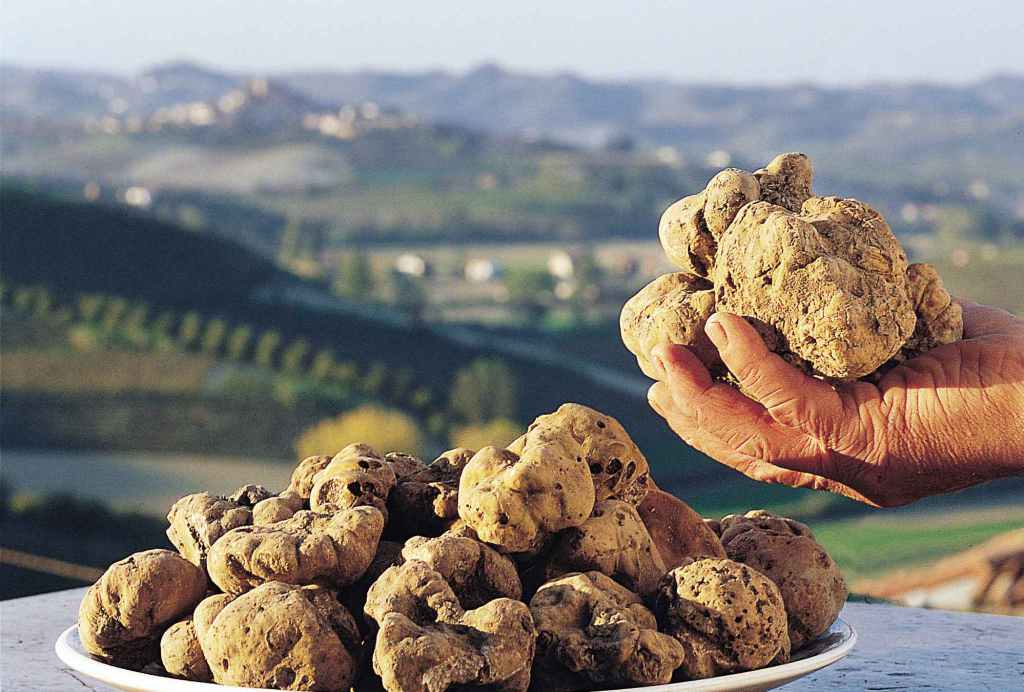 Truffle is a tuber that with its smell, legends and history won the whole world from the most extraordinary woods of Italian mountains. It is rare, precious, but very versatile. It adds refinement, taste, and decision to every dish. It has an elegant strength for demanding consumers, but also for people who appreciate country flavours: a double face, both noble and rustic, that attracts attention as a magnet of flavour. At table, the word ‘truffle’ immediately evokes the word ‘tasty’.
Truffle is a tuber that with its smell, legends and history won the whole world from the most extraordinary woods of Italian mountains. It is rare, precious, but very versatile. It adds refinement, taste, and decision to every dish. It has an elegant strength for demanding consumers, but also for people who appreciate country flavours: a double face, both noble and rustic, that attracts attention as a magnet of flavour. At table, the word ‘truffle’ immediately evokes the word ‘tasty’.
Italy is a land of truffles, where local producers of every region defend with all their might the supposed first position of their tuber in the hit parade of flavour and alimentary excellence. It is an alimentary ‘war’ that boasts export and devoted of truffle, coming mainly from North America and Middle East.
White or Black?
In Umbria, green heart of Central Italy, and especially in the province of Perugia, land of prehistoric tradition for truffle, the ‘struggle’ shifts to its colour. White or black? The dispute is open and has no solution, to flavour lovers’ joy. In this land, both local communities and entrepreneurs are united in order to promote this luxury product, either white or black.
White truffle comes to maturity between September and December, in the enchanted woods of hazel, poplar, willow, and linden. The tuber called ‘white truffle’ that arrives in the tables is characterized by a ochre yellow colour, intense perfume with scents of both garlic and grana cheese. It is ideal when eaten uncooked, with salads, pasta, and in general terms first courses, and for making precious vegetables and cooked legumes.
Black truffle offers its utmost organoleptic glamour when flambé and is used in anyhow delicate cookings. With its dark colour, bright veins, and ferruginous stones, it is considered as the ‘poor brother’ of the more valuable white truffle. It shows strong, intense flavours, that offer to the fond of not banal cooking an emotion of taste as well as Italian history.
The history of truffle is linked to history of Italy, but also of Umbrian excellence, with scent of luxury and flavour as well as scent of history. A legend tells that it came out of a lightning fulminated against an oak by Jupiter. Umbrian truffle silently crossed Middle Age, accompanied by suspicion, because it was seen as a food for witches. It was then appreciated again during Renaissance, when looking for truffles with dogs became an elegant play at court. Then, some famous personalities let know Umbrian truffles. Among them, Camillo Benso Count of Cavour: even if he came from Piedmont - another important district of production of this tuber - he used truffles of Perugia for his diplomatic wiles with Vatican.
Gioacchino Rossini defined truffle ‘Mozart of mushrooms’, and Lord Byron kept one of these tubers on his writing desk, so that its intense aroma stimulated his creativity.
Truffle light all over the world
Norcia, Scheggino, Cascia, Pietralunga, Citerna, Gubbio, Città di Castello, and Valtopina are the countries that shine thanks to truffle light. Because of its precious value, that is not only the economic one, the big chefs consider Umbrian truffle as a jewel that cannot be absent in the big gastronomic occasions, as well as in the most important events for completing their look. These countries in the municipality of Perugia are linked all the year round. They live moments of glory during summer, too, with ‘scorzone’, another very appreciated truffle. The Chamber of Commerce of the municipality of Perugia promotes its truffles with the entrepreneurial project ‘Tipicamente Umbria’ (Typically Umbria). A land surrounded between the two Italian seas, no more Latium, not Toscana yet, proud of this tuber.
Glass is the typical packaging that accompanies truffles and, above all, truffle-based products all over the world. For people fond of these flavours, the special truffle cutter is an important tool. It must be rigorously made in steel, in order to gently, but also firmly treat the precious tuber. The delicacy of the tuber, that is kept cool and scrupulously attached to the earth that covered it, is exalted by the rustic cardboard boxes that envelop glass and protect truffle against light. Sauces, truffle oil, creams, compotes, paste, fondue, butter, and flour equip the rich offer of this tuber, for chefs and gourmets all over the world.
It is in the heart of Scheggino, a little country that counts 488 inhabitants, famous in the world thanks to truffle. Scheggino is an enchanted village, symbol of a slow and tasty Italy, the classic ‘crèche village’, where truffle is economy, but also love for earth and gastronomic tradition. The river Nerea crosses the historic centre of this country, reminding the visitor how nature is worth here. The truffle museum, located in the seat of the first company that began to export it, is an experience that tells about the most important Umbrian truffle-sellers, Urbani family, and their life-story. From their black-and-white photos it is possible to learn how search, working, preservation, and spread of this famous tuber happened. The quarrymen of that time, working women’s faces, the first women who worked outside home, many histories that tell about both flavours and economy, as it happened for hand written invoices, telegrams, and mails received from USA, where a part of Urbani family had moved in order to spread the culture of truffle.


